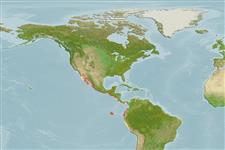Classification / Names
Common names from other countries
Main reference
Size / Weight / Age
Max length : 18.4 cm TL male/unsexed; (Ref. 96339); common length : 8.0 cm SL male/unsexed; (Ref. 9291)
Environment
Marine; brackish; pelagic-neritic; depth range 0 - 50 m (Ref. 188), usually 1 - 7 m (Ref. 96339)
Climate / Range
Tropical, preferred ?; 33°N - 17°S, 115°W - 76°W (Ref. 188)
Distribution
Eastern Pacific: La Jolla, California to Peru (at least to Callao), including the Gulf of California (Ref. 35601). (This species seems to have two forms or subspecies: Harengula thrissina thrissina from the Gulf of California to Panama and Harengula thrissina peruana from Panama to Peru).
Countries | FAO areas | Ecosystems | Occurrences | Introductions
Short description
Dorsal
spines
(total): 0;
Dorsal
soft rays
(total): 13-21;
Anal
spines: 0;
Anal
soft rays: 15 - 17. tooth plate on tongue and tooth plate behind it (basihyal and basibranchial tooth plates) broad, their width about 3 to 5 times in their combined lengths. Last dorsal fin ray not elongate (cf. Opisthonema).
IUCN Red List Status (Ref. 115185)
Threat to humans
Harmless
Human uses
Fisheries: subsistence fisheries; bait: occasionally
More information
ReferencesAquacultureAquaculture profileStrainsGeneticsAllele frequenciesHeritabilityDiseasesProcessingMass conversion
Tools
Special reports
Download XML
Internet sources
Estimates of some properties based on models
Phylogenetic diversity index
PD50 = 0.5625 many relatives (e.g. carps) 0.5 - 2.0 few relatives (e.g. lungfishes)
Trophic Level
3.1 ±0.30 se; Based on food items.
Resilience
High, minimum population doubling time less than 15 months (Preliminary K or Fecundity.)
Vulnerability
Low vulnerability (16 of 100)
Price category
